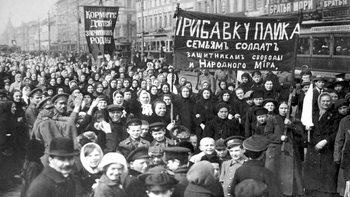Winterflower Revolution
| Winterflower Revolution | |||||||
|---|---|---|---|---|---|---|---|
| Part of Collapse of the Khraelyi Monarchy | |||||||
 Protestors in Suzir'ya, January 24, 1901 | |||||||
| |||||||
| Belligerents | |||||||
| |||||||
| Commanders and leaders | |||||||
| Strength | |||||||
| Soliriv Police: 3,400 | Unknown | ||||||
| Casualties and losses | |||||||
| 1,481 killed in Soliriv | |||||||
The Winterflower Revolution[a], commonly known as the January Revolution, January Coup, and the Khraelyi Revolution is the revolution that ended the monarchy in Khraelyia.
The main events of the revolution took place in and around the capital city of Soliriv, as well as cities such as Artemenkohrad, Suzir'ya, Lisivka, and Alapayiv. The revolution began with a general strike following then-king of Khraelyia Mykhail V's attempt to pass Resolution 148, which was designed to further increase grain quotas both in Khraelyia, and in the West Colythesian Company following the Zhaluzhnyi Eruption in 1886, where some effects from the crisis had yet to be reversed. Revolutionary activity lasted for about twenty-five days, consisting of mass demonstrations, violent altercations with law enforcement, and the destruction of monarchist symbolism towards the end. On 6 February, the forces of the capital's garrison sided with the revolutionaries. Four days later Mykhail V and his family fled the country, seeking refuge in the Secrazchak Kingdom and ending Karashkevych dynastic rule. The Provisional Congress then proclaimed the Provisional Government of Khraelyia, which replaced the Parliament of Khraelyia until 20 May.
The Provisional Government proved to be rather successful, reversing the martial law that the king placed over the country, while also maintaining internal stability. The Federal Republic of Khraelyia was officially established on May 20, 1901, following three months of the Provisional Government's existence. The inaugural president, former prime minister of the Kingdom of Khraelyia, Bohdan Kovalenko implemented numerous initial reforms to aid the populace, as well as reversing the attempted Resolution 148 alongside the relaxation of economic and agricultural policies, among other reforms.
The revolution appeared to have broken out without any real leadership or formal planning. Khraelyia was suffering from numerous socioeconomic problems following the Great Famine, such as a migration crisis as well as increasing discontent at home in the working class, especially farmers and labourers. As more of the city garrison's forces defected to the protestors throughout the city, it led to the king's decision to flee the country, fearing his own capture and possible imprisonment or death by the growing-violent protests.
Causes
A number of factors contributed to the Winterflower Revolution, both short and long-term. Historians often agree on the major causes, such as economic instability and a discontent populace. Nathan Woodroofe summarises the main and long-term causes.
"The January Revolution of 1901 ... grew out of a long-growing discontent within the populace, technological backwardness, political and economic instability, coupled with gross mismanagement of the nation, domestic economic dislocation, and outrageous scandals surrounding the monarchy."